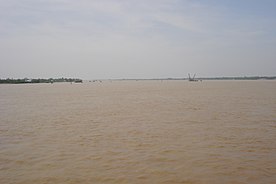Bassac River
| Bassac River Tonlé Bassac | |
|---|---|
 The wide Bassac River near Cần Thơ in the heart of the Mekong Delta | |
| Native name | ទន្លេបាសាក់ (Khmer) |
| Location | |
| Country | Cambodia, Vietnam |
| City | Phnom Penh |
| Physical characteristics | |
| Source | Mekong River |
| • location | Phnom Penh |
| Mouth | |
• location | South China Sea, Sóc Trăng Province |
• elevation | 0 m (0 ft) |
| Length | 190 km (120 mi) |
| Discharge | |
| • location | Phnom Penh |
| Basin features | |
| Tributaries | |
| • right | Bình Di River |
The Bassac River (Khmer: ទន្លេបាសាក់; Tonlé Bassac) is a distributary of the Tonlé Sap and Mekong River. The river starts in Phnom Penh, Cambodia, and flows southerly, crossing the border into Vietnam near Châu Đốc. The name Bassac comes from the Khmer prefix “pa” (father or male) added to sak (សក្តិ) (power or honor), [1] a Khmer word borrowed from the Sanskrit “sakti” (शक्ति).
In Vietnam it is known as the Hậu River (Sông Hậu or Hậu Giang in Vietnamese).
The Bassac River is an important transportation corridor between Cambodia and Vietnam, with barges and other craft plying the waters. A city of the same name was once the west-bank capital of the Kingdom of Champasak.[2] Sak (សក្តិ) can also be seen in the Khmer spelling of Champasak; (ចំប៉ាសក្តិ). USS Satyr (ARL-23), a recommissioned repair ship originally built for the United States Navy during World War II, served on the Bassac River during the Second Indochina War.[3]
Three bridges span the Bassac: the Monivong and Takhmao bridges in Phnom Penh, Cambodia and the Cần Thơ Bridge in Cần Thơ in Vietnam.
Approximately 8.5 kilometers to prey basak lies an old ancient temple ruins Prasat Prey Basak which was destroyed during the Vietnam war due to heavy bombing from the United States military. Prasat Prey Basak Temple was built during the Funan empire during the 2nd and 3rd centuries. The temple is dated between 1900 and 2000 years old. It is considered to be the oldest Prasat in Cambodia since it was dated back before Chenla during the Funan era.
References[]
- ^ Lewitz, Saveros (1967). "La Toponymie Khmère" (PDF). Bulletin de l'École française d'Extrême-Orient. 53 (2): 421–422, 425. doi:10.3406/befeo.1967.5052 – via Angkordatabase.asia.
- ^ Murdoch, John B. (1974). "The 1901-1902 Holy Man's Rebellion" (PDF). Journal of the Siam Society. Siam Heritage Trust. JSS Vol.62.1 (digital): images 4–5, map image 13. Retrieved April 2, 2013.
Bassac was an important economic center, for it was the outlet for the trade from the east bank of the Mekong, including the Bolovens Plateau, Sara vane, Attopeu, and Kontum Plateau regions. From Bassac, trade in cardamon, rubber, wax, resin, skins, horns, and slaves, was conducted with Ubon, Khorat, and Bangkok.
- ^ "The ARL-23 in Vietnam Operations Map". The ARL-23 in Vietnam. usssatyr.com. September 24, 2013. Archived from the original on September 14, 2013. Retrieved October 27, 2013.
Coordinates: 9°31′N 106°13′E / 9.517°N 106.217°E
- Bassac River
- Distributaries
- Rivers of Cambodia
- Tonlé Sap
- Mekong River
- Geography of Phnom Penh
- International rivers of Asia
- Rivers of An Giang province
- Rivers of Cần Thơ
- Rivers of Hậu Giang province
- Rivers of Sóc Trăng province
- Rivers of Trà Vinh province
- Rivers of Vĩnh Long province
- Rivers of Vietnam
- Asia river stubs
- Cambodia geography stubs
- Vietnam river stubs
